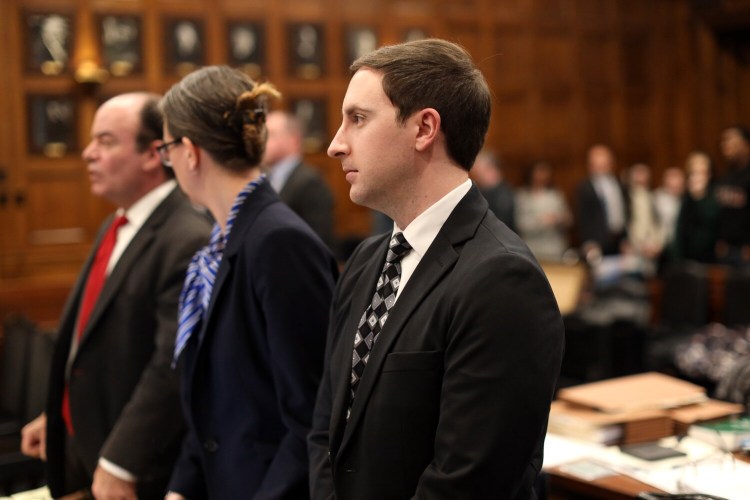A surveillance camera in a police station waiting room captured snippets of a mumbled conversation between Mark Cardilli Jr. and his father in the first hours after the son shot and killed Isahak Muse.

Isahak Muse Carl D. Walsh/Staff Photographer
In video footage that was played in Cumberland County Superior Court on Tuesday morning, Mark Cardilli Sr. said he thought the weapon was an Airsoft gun.
“I didn’t even know it was real,” the father said. “That’s why I didn’t say anything. I thought you were just trying to scare him.”
Mark Cardilli Jr. said something about being pushed and beaten, although his exact words were difficult to distinguish on the recording.
“I wasn’t going to play around anymore,” the son said.
Cardilli Jr., 25, is charged with murder in Muse’s shooting death, and his trial began Monday in front of Superior Court Justice Nancy Mills. The state rested its case against him Tuesday afternoon.
The only member of the Cardilli family to testify so far has been Chelsey Cardilli, who is the defendant’s younger sister and was dating Muse, 22, at the time of his death early on March 16. The young woman, now 18, described a chaotic family altercation before the fatal shooting.
She also recounted racist statements her brother made in recent years, including derogatory statements about people who are from Somalia and who are Muslims. Muse was a black Muslim man from a Somali family, and the Cardillis are white.
The state called witnesses from the investigation Tuesday, including a state ballistics expert and police officers who collected data from cellphones in the case. They clicked through photos of the fight’s aftermath – a strewn pair of Nikes, a broken but manicured fingernail and the open safe from which Cardilli had retrieved his gun that night.
An evidence technician described shell casings and bullet fragments collected from the shooting scene, as well as blood spatter on the walls.
The attorneys disagreed over how much that technician could testify about the blood spatter, and the defense appeared to object to any testimony about the position or movement of any people involved in the shooting.
A police affidavit filed in April explicitly states the blood spatter was near the floor and suggested Muse was not standing when Cardilli Jr. shot him in the back. But when evidence technician Victor Cote took the stand, he was only asked to describe his photos from the scene. In the images of blood spatter, he explained the measurements he took on the wall, which were less than 3 feet from the floor.
The defense also called police officers who had been involved in the investigation, trying to cast doubt on the forensic evidence from the chief medical examiner and the ballistics expert. Both testified that the bullets hit Muse in the back and exited his chest. Police officers who responded to the scene found Muse on his back where the Cardilli family members and first responders tried to render aid. At least two indicated in their reports that Muse had been shot in the chest.
The defense also played a video of police investigators interviewing Chelsey Cardilli and her attorney in October.
Muse had a graze wound on his eyebrow and the hood of his sweatshirt had some apparent damage from a gunshot, and during the interview police asked Chelsey Cardilli whether she could remember how he wore the hood that night. She said it might have been up when the fighting started. On the stand Monday, the teenager testified that she could not remember the position of her boyfriend’s hood.
The defense offered that video clip as a way to discredit the young woman’s testimony, and while the state objected, Assistant Attorney General Leanne Robbin told the judge she did not think it would be important in her decision making.
The defense also called a man who had served with Cardilli Jr. in the U.S. Army. David Gutierrez was a staff sergeant and is now retired from the military, but they were stationed together at Fort Drum in New York.
Gutierrez described the firearms training they received, saying the military focused on rifles over pistols. He also described Cardilli Jr. as a person who did not treat anyone differently because of race or religion, and he said the former sergeant was good at helping other soldiers resolve their conflicts.
Comments are not available on this story.
Send questions/comments to the editors.


